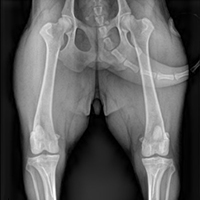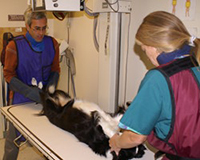|
Click on image to see more x-rays
|
BVS has developed a mobile radiology facility designed to offer services at dog show venues. This has eliminated the need for clients to drive great distances to locate a veterinarian taking OFA x-rays without anesthesia or sedation. We are also certified to take Penn Hip x-rays and provide this service at dog shows as well. The latter requires general anesthesia so they are always taken at the end of the day after all OFA x-rays are finished. This allows us to give our full attention to anesthetized patients.
Hip dysplasia, elbow dysplasia, Legg-Calve-Perthes disease and Osteochondritis Dissicans (OCD) are common genetic problems that require xrays to diagnose. Certification by the Orthopedic Foundation for Animals (OFA) or Penn Hip are routine procedures. The great majority of veterinarians require general anesthesia to take these x-rays. Although it is required for Penn Hip films, and it may help with positioning for OFA films allowing less radiation exposure of the staff, it is not required by the OFA. It is not uncommon for animals to appear to have hip joint laxity (one of the hallmarks and early signs of hip dysplasia) under anesthesia and very tight hips without it. In our practice it is common to have patients come to us after having been told their pet’s hips were dysplastic when taken with anesthesia and when retaken without are found to have normal hip conformation and pass OFA certification.
Contrary to some opinions, we are not finding that the incidence of these animals growing up and developing clinical and radiographic signs of hip dysplasia is any higher than the incidence of this occurring in the population that pass OFA with the use of anesthesia. Clients will often drive great distances to find veterinarians who are willing to perform this simple procedure without having to leave their pets at the veterinary hospital for a full day. Although modern anesthesia is very safe, it has it’s own set of risks, and costs and it requires substantial time, labor and monitoring equipment to minimize the risk.*
Most veterinarians prefer not having the pet’s owner present during the procedure. It is our belief that pets are easier to position when their owners are in the room to calm and support them. It is rare for a complete set of high quality hip and elbow xrays to require more than 15 minutes to complete. In addition, by utilizing new direct digital radiography even more time is saved in the process. One of the downsides of not using sedation is that the pet may move during the procedure.
With conventional film radiographs, we often don’t know that until several minutes later when they are developed. Digital radiography comes in both Direct Digital and Computed Radiography. Computed Radiography can achieve the quality of digital at a lower cost than Direct Digital but does so at the expense of time. As with conventional films, it requires the removal of a “plate” from under the x-ray table and placement in a processor which often takes as long as a conventional film. With direct digital technology, there is no film or plate. The image appears within 6 seconds of exposure while the pet is still positioned on the table. It takes no more than a glance at a monitor next to the table to know what is needed to correct positioning and retake the image. Film based radiographs can be of very high quality however to achieve this often requires several tries and considerable time. The quality of our digital images is far superior to that of the average film we evaluate. Exposure corrections can be made after the patient is off the table by utilizing software rather than having to reshoot the image.
BVS made the decision to acquire Direct Digital technology in a mobile format in order to bring the service to our clients rather than making them drive great distances to visit our facility. Now it is easier than ever to have what previously required clients to take an entire day off to perform.
For more information about Canine Hip Dysplasia, Elbow Dysplasia, Legg-Calve-Perthes Disease and Osteochondritis Dissicans go to www.offa.org.
|
AXITY |



